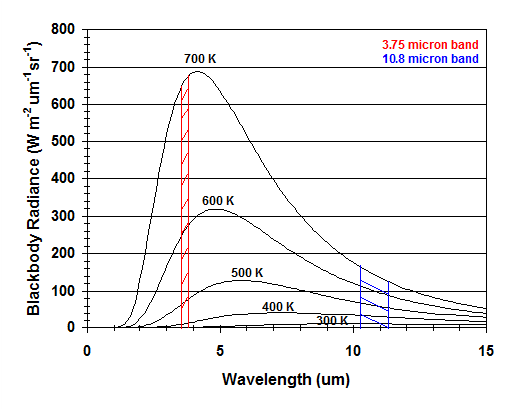Algorithm description
 The WFABBA fire algorithm is a dynamic multispectral thresholding contextual algorithm that uses the shortwave "visible" channel (when available during the daytime), middle infrared (3.9 μm), and longwave infrared (11.2 μm) infrared window bands to locate and characterize hot spot pixels. The fire detection algorithm is based on the sensitivity of the 3.9 μm band to high temperature sub-pixel anomalies compared against the less sensitive longer wavelength IR window bands, specifically the 11.2 μm band. This concept is illustrated to the right where blackbody radiance is shown as a function of wavelength at increasing temperatures. This fire detection technique was originally developed by Matson and Dozier (1981) for data from NOAA’s Advanced Very High Resolution Radiometer (AVHRR). The shortwave “visible” band, when available, improves the cloud screening and establishes the surface albedo value which aids in reducing the effects of solar contamination in the 3.9 μm band.
The WFABBA fire algorithm is a dynamic multispectral thresholding contextual algorithm that uses the shortwave "visible" channel (when available during the daytime), middle infrared (3.9 μm), and longwave infrared (11.2 μm) infrared window bands to locate and characterize hot spot pixels. The fire detection algorithm is based on the sensitivity of the 3.9 μm band to high temperature sub-pixel anomalies compared against the less sensitive longer wavelength IR window bands, specifically the 11.2 μm band. This concept is illustrated to the right where blackbody radiance is shown as a function of wavelength at increasing temperatures. This fire detection technique was originally developed by Matson and Dozier (1981) for data from NOAA’s Advanced Very High Resolution Radiometer (AVHRR). The shortwave “visible” band, when available, improves the cloud screening and establishes the surface albedo value which aids in reducing the effects of solar contamination in the 3.9 μm band.
The contextual nature of the algorithm refers to the processes where neighboring pixels are used to help identify hotspots and the number of pixels considered varies as the window is allowed to expand until enough cloud-free background land pixels free of thermal anomalies are identified. The background window does not increase without limit and can only reach a size of 105 by 105 pixels. The algorithm incorporates statistical techniques such as mean, standard deviation, and histogram approaches to automatically identify hot spot pixels in the satellite imagery while limiting the number of false detections. The current MODIS (Giglio et al., 2003) and proposed VIIRS fire algorithms offer many similarities with the WFABBA.
Once the WFABBA locates a hot spot pixel, it incorporates ancillary data in the process of screening for false alarms and correcting for water vapor attenuation, surface emissivity, solar reflectivity, and semi-transparent clouds. A rudimentary correction is also included to correct for diffraction. Various land, desert, and coastal masks are used to screen out non-fire regions and regions that are known to be highly reflective and to assist in eliminating false alarms. The NCEP model total column precipitable water products are utilized to correct for water vapor attenuation. Numerical techniques are used to determine instantaneous estimates of subpixel fire size and average temperature using a modified Dozier (1981) technique. For more information on the heritage WFABBA algorithm and the determination of subpixel fire characteristics, refer to Prins and Menzel (1992; 1994) and Prins et al. (1998; 2001; 2003).
The WFABBA fire product is produced as frequently as an Imager produces an image which and provides diurnal fire detection and sub-pixel fire characterization (e.g. instantaneous estimates of sub-pixel fire size, temperature, and FRP) for data within a satellite view angle of 80 degrees; the actual Imager coverage schedule varies by satellite. The final user output consists of a fire product providing a pixel-by-pixel mask indicating fire locations and categorizations as well as information on how the algorithm made decisions about all over pixels. For each fire of the appropriate types, instantaneous estimates of fire size and temperature, and fire radiative power are also provided.

Algorithm Description : History : Applications : Ongoing Work : People





